Antarctica, a Continent of all of us who inhabit this planet, has temples surrounded by ice and snow that can also be visited. 60 cruise ships surround yearly the white Continent, some of those departures will offer the tourists to see its chapels. The women and men who are in Antarctica live their faith in a very special way in chapels belonging to the different installed bases.
Battered by climate change, the native organisms of this continent include a myriad of types of algae, bacteria, fungi, plants and animals, the true inhabitants of its landscape. However, decades of research around the latter, including its organisms, has established a more or less standard population scattered throughout many of its corners, and in order to make sense of the world, even there, and even among science, there is a need for faith, there is a need for religion, there is a need of prayer.
Among the ice in all its forms, in addition to more ice, there are some Churches. They are few, but each one more curious!  One of the southernmost buildings in Antarctica is, curiously, a religious building. Let’s think about the St. Ivan Rilski Chapel, the first Eastern Orthodox edifice in Antarctica and the southernmost Eastern Orthodox building of worship in the world. Located at the Bulgarian Research Station, San Kliment Ohridski Base (WAP BUL-Ø1) on Livingston Island, in the South Shetland, it has been the first Orthodox temple on the Icy Continent and the southernmost until the construction of St. Vladimir’s Chapel at Ukraine’s Vernadsky Base (WAP UKR-Ø1) in 2011.
One of the southernmost buildings in Antarctica is, curiously, a religious building. Let’s think about the St. Ivan Rilski Chapel, the first Eastern Orthodox edifice in Antarctica and the southernmost Eastern Orthodox building of worship in the world. Located at the Bulgarian Research Station, San Kliment Ohridski Base (WAP BUL-Ø1) on Livingston Island, in the South Shetland, it has been the first Orthodox temple on the Icy Continent and the southernmost until the construction of St. Vladimir’s Chapel at Ukraine’s Vernadsky Base (WAP UKR-Ø1) in 2011.
 It is not only its location, but also its peculiar shape that catches the eye: St. Ivan Rilski Chapel it’s a small trapezoidal building measuring 3.5 meters by 12 meters made of red metal that rests on small pillars.
It is not only its location, but also its peculiar shape that catches the eye: St. Ivan Rilski Chapel it’s a small trapezoidal building measuring 3.5 meters by 12 meters made of red metal that rests on small pillars.
Built in 2003, among its features a bell donated by Nikola Vasilev, former deputy prime minister of Bulgaria, who worked as a doctor at the base between 1993 and 1994, also a cross donated by Bulgarian artist Dicho Kapushev, an icon of Jesus Christ betrothed by Bulgarian artist Georgi Dimov and an icon of St. John of Rila donated by Bulgarian President Georgi Parvanov.
But, Did you know that Argentina built the first church in Antarctica?
Although it is not the site where the first mass of the “White Continent” was organized, it is the oldest Catholic temple.  Touring the facilities of the huge Esperanza Base (WAP ARG-Ø4) which Argentina has managed since December 17, 1952, a visitor can’t avoid to see the structure of the first church in Antarctica. This small temple, known as “St. Francis of Assisi Chapel” has stood at the northern tip of the Antarctic Peninsula for almost half a century and still surprises those who observe it for the first time. Currently, it is part of the small list of Catholic churches in Antarctica and preserves some very important religious objects, which were given as donations from Pope Francis in the last decade.
Touring the facilities of the huge Esperanza Base (WAP ARG-Ø4) which Argentina has managed since December 17, 1952, a visitor can’t avoid to see the structure of the first church in Antarctica. This small temple, known as “St. Francis of Assisi Chapel” has stood at the northern tip of the Antarctic Peninsula for almost half a century and still surprises those who observe it for the first time. Currently, it is part of the small list of Catholic churches in Antarctica and preserves some very important religious objects, which were given as donations from Pope Francis in the last decade.
 The first church in Antarctica is the colorful Chapel of St. Francis of Assisi, which opened its doors on February 18, 1976. At that time, its priest was the Jesuit Buenaventura De Filippis, who was born in Italy and spent an important part of his life at the Esperanza base in Argentina. And, curiously, this chapel was also the place where, two years after its inauguration, the first religious wedding in Antarctica was organized.
The first church in Antarctica is the colorful Chapel of St. Francis of Assisi, which opened its doors on February 18, 1976. At that time, its priest was the Jesuit Buenaventura De Filippis, who was born in Italy and spent an important part of his life at the Esperanza base in Argentina. And, curiously, this chapel was also the place where, two years after its inauguration, the first religious wedding in Antarctica was organized.
The first Mass in Antarctica was celebrated on February 20, 1946 and was organized by the Jesuit Felipe Lerida, in the Stella Maris Chapel of Argentina’s Orcadas Base (WAP ARG-15). After the Mass, the priest sent a telegram to Pope Pius XII: “First Mass celebrated. Cross erected”. But, for the next 30 years, the continent continued without Catholic temples on its territory.
Thanks and credit to:Las iglesias más australes del mundo están en la Antártida (elconfidencial.com) and ¿Sabías que Argentina construyó la primera iglesia de la Antártida? – Billiken

 Thanks to the efforts of the staff actually on Petrel Base (
Thanks to the efforts of the staff actually on Petrel Base ( A celebration held at Argentinean Base San Martín (
A celebration held at Argentinean Base San Martín (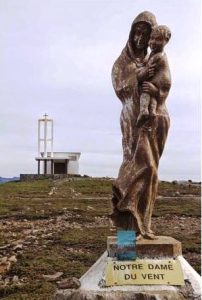 Also known as the Desolation Islands, the Kerguelen archipelago consists of 300 islands, islets, and reefs which lie between 48° to 50° South and 68° to 70° East, covering an area of 7,215 km² (2,786 mi²) .
Also known as the Desolation Islands, the Kerguelen archipelago consists of 300 islands, islets, and reefs which lie between 48° to 50° South and 68° to 70° East, covering an area of 7,215 km² (2,786 mi²) .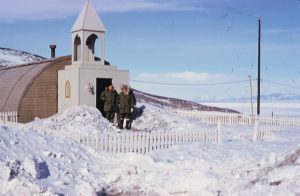 Year 1956
Year 1956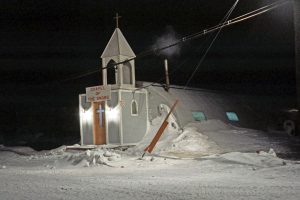 However, according Admiral George Dufek, who commanded Deep Freeze I, “As the construction of the buildings at McMurdo progressed a mysterious pile of lumber, planks, nails, Quonset hut sections, and assorted materials began to accumulate on a knoll overlooking the camp.” Just few years later the Chapel was renamend as Chapel of the Snow (aka Blue Chapel . Picture aside show how the Chapel was in 1963 and Blue Chapel 1968.
However, according Admiral George Dufek, who commanded Deep Freeze I, “As the construction of the buildings at McMurdo progressed a mysterious pile of lumber, planks, nails, Quonset hut sections, and assorted materials began to accumulate on a knoll overlooking the camp.” Just few years later the Chapel was renamend as Chapel of the Snow (aka Blue Chapel . Picture aside show how the Chapel was in 1963 and Blue Chapel 1968.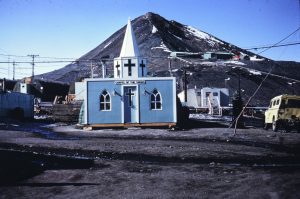 The Chaplain, Father John C. Condit, and volunteers from the construction battalion gradually gathered enough materials to build what was to become the first church ever erected in Antarctica. All of the work was done by volunteers after their daily duties were finished. Admiral Dufek also observed that “The men, after a hard day’s work, would drift over to the church site. Before the main camp was finished a tidy neat church with a steeple was to stand on a ridge overlooking the camp. Later it even had a bell, procured from a small gasoline tanker.” When the Chapel was completed, Father Condit had the world’s most southern parish.
The Chaplain, Father John C. Condit, and volunteers from the construction battalion gradually gathered enough materials to build what was to become the first church ever erected in Antarctica. All of the work was done by volunteers after their daily duties were finished. Admiral Dufek also observed that “The men, after a hard day’s work, would drift over to the church site. Before the main camp was finished a tidy neat church with a steeple was to stand on a ridge overlooking the camp. Later it even had a bell, procured from a small gasoline tanker.” When the Chapel was completed, Father Condit had the world’s most southern parish.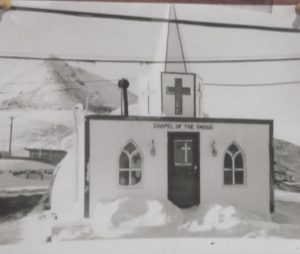 Year 1979
Year 1979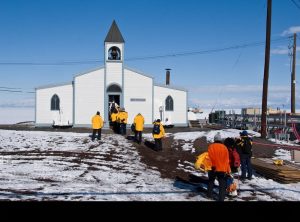 Year 1989
Year 1989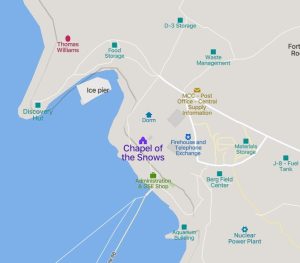 McMurdo Station once again has a permanent place of worship. To commemorate this occasion, approximately 80 people gathered on Sunday, 29 January 1989 to dedicate the new Chapel of the Snows, which is the third chapel to be raised at the station.
McMurdo Station once again has a permanent place of worship. To commemorate this occasion, approximately 80 people gathered on Sunday, 29 January 1989 to dedicate the new Chapel of the Snows, which is the third chapel to be raised at the station.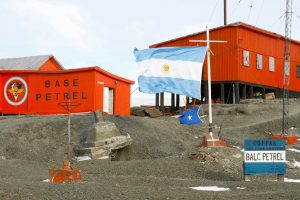 Renovation work continues on the infrastructure of the Petrel Joint Antarctic Base (
Renovation work continues on the infrastructure of the Petrel Joint Antarctic Base (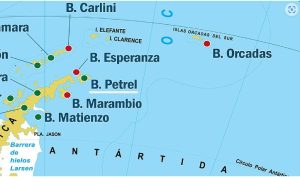 The complete repair of the road to the Main Power Plant, the demolition of the old power plant and the bases of disused communication towers, are part of this second phase of development together with the renovation of the landing strips and the disposal of waste. antarctics
The complete repair of the road to the Main Power Plant, the demolition of the old power plant and the bases of disused communication towers, are part of this second phase of development together with the renovation of the landing strips and the disposal of waste. antarctics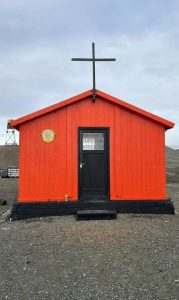 Also, Petrel Base has already inaugurated its new small
Also, Petrel Base has already inaugurated its new small 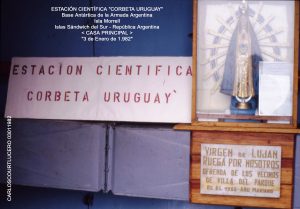 Carlos, reports to have been to the Scientific Station of Corbeta Uruguay (Estación Científica Corbeta Uruguay), among the IV Dotation Winter 1981.
Carlos, reports to have been to the Scientific Station of Corbeta Uruguay (Estación Científica Corbeta Uruguay), among the IV Dotation Winter 1981. Thanks to Lt.Danilo Collino IZ1KHY who was recently involved in the 37th Italian Antarctic Season (October 2021 trough February 2022), we have got some recent pictures of the “Chapel of the Snow”, the church been visited by Danilo on his brief stay at McMurdo Station (
Thanks to Lt.Danilo Collino IZ1KHY who was recently involved in the 37th Italian Antarctic Season (October 2021 trough February 2022), we have got some recent pictures of the “Chapel of the Snow”, the church been visited by Danilo on his brief stay at McMurdo Station ( Situated at the end of town, McMurdo Station’s small, blue and white “Chapel of the Snows” stands out against the comparatively drab shipping container-like structures surrounding it. Visitors who step inside the wooden building enter a cozy sanctuary, complete with shelves full of hymnals, musical instruments at the back of the room, and a stained glass window above the pulpit. Other than the black and white penguin embedded in the stained glass, it looks much like any small church around the world.
Situated at the end of town, McMurdo Station’s small, blue and white “Chapel of the Snows” stands out against the comparatively drab shipping container-like structures surrounding it. Visitors who step inside the wooden building enter a cozy sanctuary, complete with shelves full of hymnals, musical instruments at the back of the room, and a stained glass window above the pulpit. Other than the black and white penguin embedded in the stained glass, it looks much like any small church around the world. Chaplain Arthur “Tom” Paine said: “This multi-denominational chapel is for everybody. Months-long deployments away from home can be difficult for many, and the station’s chapel is there to provide a place for people to find personal support and guidance if they need it.”
Chaplain Arthur “Tom” Paine said: “This multi-denominational chapel is for everybody. Months-long deployments away from home can be difficult for many, and the station’s chapel is there to provide a place for people to find personal support and guidance if they need it.”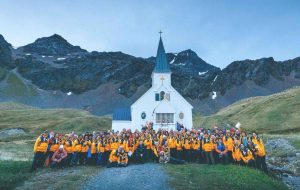 “The Whalers’ Church” is a typical Norwegian timber church. It was commissioned, and largely financed, by Carl Anton Larsen and designed by his son inlaw , architect. The Church was prefabricated in Strømmen, Norway, and erected by the Station workers in their spare time. The two bells in the steeple rung out on 1913’ Christmas Eve. On the following day, Solveig Jacobsen, granddaughter of CA Larsen, was baptised by the pastor Kristen Løken.
“The Whalers’ Church” is a typical Norwegian timber church. It was commissioned, and largely financed, by Carl Anton Larsen and designed by his son inlaw , architect. The Church was prefabricated in Strømmen, Norway, and erected by the Station workers in their spare time. The two bells in the steeple rung out on 1913’ Christmas Eve. On the following day, Solveig Jacobsen, granddaughter of CA Larsen, was baptised by the pastor Kristen Løken.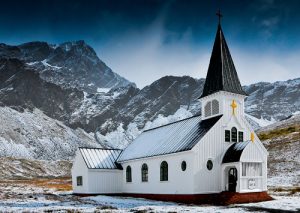 Venner (Norway’s Friends of South Georgia) who arrived on the cruise ship Fram as part of a voyage to celebrate the Church’s anniversary.
Venner (Norway’s Friends of South Georgia) who arrived on the cruise ship Fram as part of a voyage to celebrate the Church’s anniversary.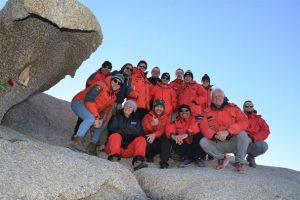
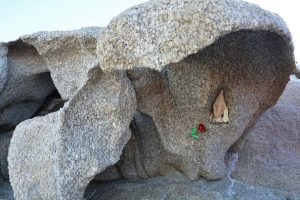 Gianfranco wrote: There is no church at MZS (
Gianfranco wrote: There is no church at MZS ( Like a letter left in the fireplace for Santa Claus, the Archibishop of Montevideo, Cardinal Daniel Sturla (
Like a letter left in the fireplace for Santa Claus, the Archibishop of Montevideo, Cardinal Daniel Sturla (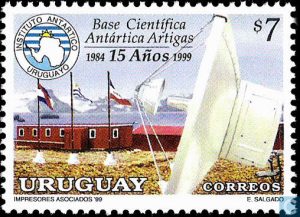 Artigas is a Base active all year round, with an allocation of 8 people in winter and 70 in summer. «We think that for our compatriots, who spend a season there , the presence of a Chapel and a place suitable for the image of our Patroness can only be of benefit» writes the Archibishop of Montevideo, Cardinal Daniel Sturla.
Artigas is a Base active all year round, with an allocation of 8 people in winter and 70 in summer. «We think that for our compatriots, who spend a season there , the presence of a Chapel and a place suitable for the image of our Patroness can only be of benefit» writes the Archibishop of Montevideo, Cardinal Daniel Sturla. But the partiotic strings, such as religious ones and those od nationals prestige, do not seem to have mobilized the Uruguayan authorities in charge of Antarctica, if. until a little less than a year, after the request was fornulated, it has not yet received an answer!
But the partiotic strings, such as religious ones and those od nationals prestige, do not seem to have mobilized the Uruguayan authorities in charge of Antarctica, if. until a little less than a year, after the request was fornulated, it has not yet received an answer! Also laconic was the head of the Army, Real Admiral Leonardo Alonso, who stated that although he does not oppose the idea, he does not see the need of another Chapel when nearby there is already a Catholic one belonging to Chile and another Ortodox belonging to Russia.
Also laconic was the head of the Army, Real Admiral Leonardo Alonso, who stated that although he does not oppose the idea, he does not see the need of another Chapel when nearby there is already a Catholic one belonging to Chile and another Ortodox belonging to Russia. Christchurch in the Southern Island of New Zealand is an outpost, an ideal location to jump down South, in Antarctica.
Christchurch in the Southern Island of New Zealand is an outpost, an ideal location to jump down South, in Antarctica.  The role of the Christchurch Antarctic Office is to co-ordinate the opportunities presented by Christchurch’s Antarctic Gateway status and to explore our historic and modern connections with the icy continent.
The role of the Christchurch Antarctic Office is to co-ordinate the opportunities presented by Christchurch’s Antarctic Gateway status and to explore our historic and modern connections with the icy continent. has flowed through Christchurch, starting over 100 years ago with the “Heroic Era” explorations of Captain Robert Falcon Scott and Sir Ernest Shackleton, who both used Christchurch as a base camp for their Antarctic expeditions».
has flowed through Christchurch, starting over 100 years ago with the “Heroic Era” explorations of Captain Robert Falcon Scott and Sir Ernest Shackleton, who both used Christchurch as a base camp for their Antarctic expeditions». Here is a testimony told by Jorge Canova, pilot of the Argentine Air Force who is sharing the image of Nuestra Señora de Loreto enthroned at Matienzo Base during the 1970/71 Antarctic campaign.
Here is a testimony told by Jorge Canova, pilot of the Argentine Air Force who is sharing the image of Nuestra Señora de Loreto enthroned at Matienzo Base during the 1970/71 Antarctic campaign.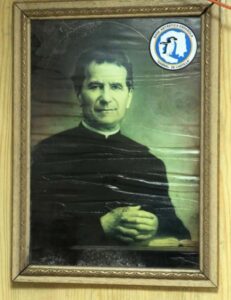 Well, if we were to go to Antarctica, we’d also find a small image of Don Bosco there too. This photo was taken 15,073 kilometers from Spain as Don Bosco is present as patron of the military contingent that accompanies environmental researchers on the Antarctic Continent.
Well, if we were to go to Antarctica, we’d also find a small image of Don Bosco there too. This photo was taken 15,073 kilometers from Spain as Don Bosco is present as patron of the military contingent that accompanies environmental researchers on the Antarctic Continent.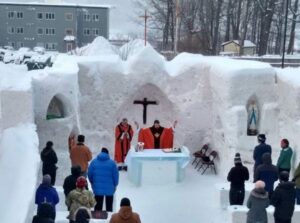 The news reporting the build of an “Ice Chapel” outside St. Albert The Great Parish on Michigan Tech’s campus, (see picture aside) reminds us the Ice chapel carved into the ice at the Argentine Base of Belgrano II (WAP ARG-Ø6) in Antarctica!
The news reporting the build of an “Ice Chapel” outside St. Albert The Great Parish on Michigan Tech’s campus, (see picture aside) reminds us the Ice chapel carved into the ice at the Argentine Base of Belgrano II (WAP ARG-Ø6) in Antarctica!
 Hope Point, 54° 17′ South, 36° 29′ 15″ West, is a rocky bluff, 20 meters (70 ft) high, which forms the north side of the entrance to King Edward Cove.
Hope Point, 54° 17′ South, 36° 29′ 15″ West, is a rocky bluff, 20 meters (70 ft) high, which forms the north side of the entrance to King Edward Cove. off on the expedition thinking the body was bound for England.
off on the expedition thinking the body was bound for England.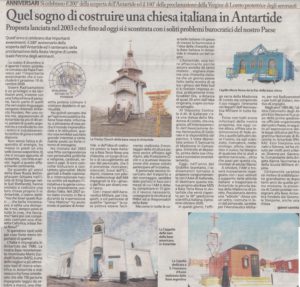 It’s an idea that comes from the heart, an idea that we have illustrated and explained in meetings, in several schools, to politicians, radio and TV, to bishops, cardinals and no less than 3 Popes in the last 13 years.
It’s an idea that comes from the heart, an idea that we have illustrated and explained in meetings, in several schools, to politicians, radio and TV, to bishops, cardinals and no less than 3 Popes in the last 13 years. Thanks to François F8DVD, we can show today an envelope with a rare Chapel of the Snow “cachet” from McMurdo Station (WAP USA-22)
Thanks to François F8DVD, we can show today an envelope with a rare Chapel of the Snow “cachet” from McMurdo Station (WAP USA-22)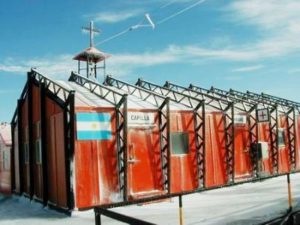 On April 16, 1996, a solemn ceremony was held at Marambio Base (WAP ARG-21), where the Military (Castrense) Bishop of the Argentine Republic in Solemn Pontifical, proceeded to bless and inaugurate the Oratory of the Base, placed under the dedication of the Blessed Virgin of Luján
On April 16, 1996, a solemn ceremony was held at Marambio Base (WAP ARG-21), where the Military (Castrense) Bishop of the Argentine Republic in Solemn Pontifical, proceeded to bless and inaugurate the Oratory of the Base, placed under the dedication of the Blessed Virgin of Luján
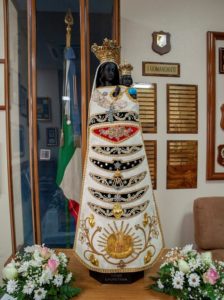
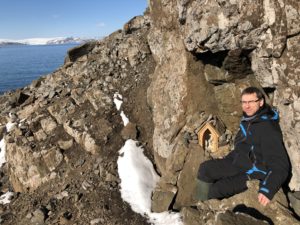 A small Czech chapel has been placed on Febr. 21, 2019 at 62°14,784′ South, 58°58,891′ West in Antarctica during an expedition to the ECO Nelson Base in the South Shetlands on the Nelson Island as already reported on Nov. 22-2019 (
A small Czech chapel has been placed on Febr. 21, 2019 at 62°14,784′ South, 58°58,891′ West in Antarctica during an expedition to the ECO Nelson Base in the South Shetlands on the Nelson Island as already reported on Nov. 22-2019 (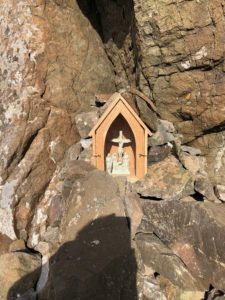 The Chapel -as told WAP by its builder Prof. Ladislav Janíček– was born from an initiative of himself (
The Chapel -as told WAP by its builder Prof. Ladislav Janíček– was born from an initiative of himself (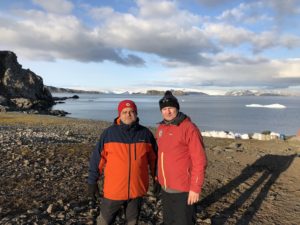
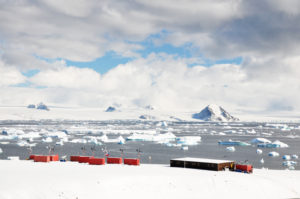
 For the anniversary of the canonization of St. Agnes of Bohemia and thanks to the Czeck polar explorers, a small chapel in honor of the Saints Wenceslaus I, Agnes of Bohemia and Ludmilla has been set in Antarctica!
For the anniversary of the canonization of St. Agnes of Bohemia and thanks to the Czeck polar explorers, a small chapel in honor of the Saints Wenceslaus I, Agnes of Bohemia and Ludmilla has been set in Antarctica! Inside the chapel there is a sculpture of “Crucifixion” and a statue of “St. Wenceslas” by Milan Houser, Tomáš Medek and Jiří Pec.
Inside the chapel there is a sculpture of “Crucifixion” and a statue of “St. Wenceslas” by Milan Houser, Tomáš Medek and Jiří Pec. The structure of the chapel is made of steel and is used for Catholic worship by the various Argentine staff members at the station (as well as visitors). The chapel has a bell tower and a cross. In the chapel there is a replica of the Virgin of Luján solemnly moved from her sanctuary in Buenos Aires before its inauguration.
The structure of the chapel is made of steel and is used for Catholic worship by the various Argentine staff members at the station (as well as visitors). The chapel has a bell tower and a cross. In the chapel there is a replica of the Virgin of Luján solemnly moved from her sanctuary in Buenos Aires before its inauguration. It was blessed and inaugurated on April 15, 1996 by Norberto Eugenio Martina, a military bishop of Argentina, on whom the Argentine Antarctic chaplain depends. Currently the chapel at Orcadas Base (WAP ARG-15) is the southernmost Catholic temple in Argentina, and one of the southernmost on the planet.
It was blessed and inaugurated on April 15, 1996 by Norberto Eugenio Martina, a military bishop of Argentina, on whom the Argentine Antarctic chaplain depends. Currently the chapel at Orcadas Base (WAP ARG-15) is the southernmost Catholic temple in Argentina, and one of the southernmost on the planet. A “Church in Antarctica” as well as any other signs or place of worship in any corners of the Icy Continent are the most sincere examples of faith and genuine places of worship; they deserve to be known.
A “Church in Antarctica” as well as any other signs or place of worship in any corners of the Icy Continent are the most sincere examples of faith and genuine places of worship; they deserve to be known. facing the Station buildings. A second bigger one, is sets little lower. Both statues are located in the great rock on which the lighthouse stands out (62°09′28″South 58°27′56″West), and people at Arctowski, call this corner “Chapel”.
facing the Station buildings. A second bigger one, is sets little lower. Both statues are located in the great rock on which the lighthouse stands out (62°09′28″South 58°27′56″West), and people at Arctowski, call this corner “Chapel”. No way to put a statue on cargo ship that brought the supplies to Arctowski. The workers hid the statue of the Virgin in a deep cargo box and smuggled it out of Polish border. Now both signs of devotion are proudly on the site that Polish staff did choose for them.
No way to put a statue on cargo ship that brought the supplies to Arctowski. The workers hid the statue of the Virgin in a deep cargo box and smuggled it out of Polish border. Now both signs of devotion are proudly on the site that Polish staff did choose for them. The “Capilla Cristo Caminante”, is located up in the hill behind San Martin Station (WAP ARG-Ø8). The pics aside show the closest shots of the Chapel of which, so far we do not have better visualizing.
The “Capilla Cristo Caminante”, is located up in the hill behind San Martin Station (WAP ARG-Ø8). The pics aside show the closest shots of the Chapel of which, so far we do not have better visualizing.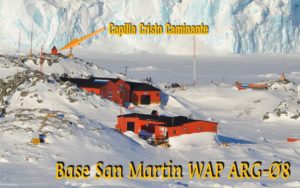

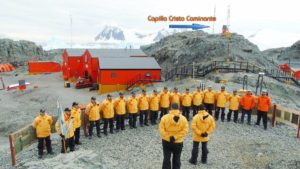
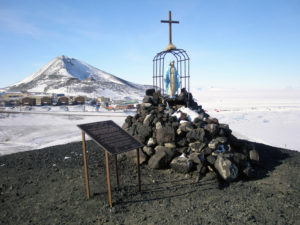 The Our Lady of the Snows shrine is one of the many memorials atop hills along McMurdo Sound to men who lost their lives in Antarctica; this one is farther up the trail from Hut Point. The Shrine is dedicated to Richard T. Williams, US Navy – Seabees, who lost his life at McMurdo Sound on January 6, 1956 during initial construction of McMurdo Station.
The Our Lady of the Snows shrine is one of the many memorials atop hills along McMurdo Sound to men who lost their lives in Antarctica; this one is farther up the trail from Hut Point. The Shrine is dedicated to Richard T. Williams, US Navy – Seabees, who lost his life at McMurdo Sound on January 6, 1956 during initial construction of McMurdo Station. General Artigas Station (WAP URY-Ø1) is the larger of the two Uruguayan scientific Research Stations in Antarctica, the other one, is Elichiribehety Base (WAP URY-NEW)
General Artigas Station (WAP URY-Ø1) is the larger of the two Uruguayan scientific Research Stations in Antarctica, the other one, is Elichiribehety Base (WAP URY-NEW) awarded in September of that year with this title by Pope Francis, begins by referring to request that came from people linked to the Artigas Base of Uruguayan Antarctica.
awarded in September of that year with this title by Pope Francis, begins by referring to request that came from people linked to the Artigas Base of Uruguayan Antarctica.
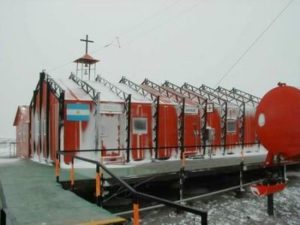 April 16th, marks the anniversary of the blessing and inauguration of the oratory of the Chapel at Base Marambio.
April 16th, marks the anniversary of the blessing and inauguration of the oratory of the Chapel at Base Marambio. oming across a social network, I found an interesting page, set by someone set foot in Antarctica and left a tangible sign of what they did!
oming across a social network, I found an interesting page, set by someone set foot in Antarctica and left a tangible sign of what they did!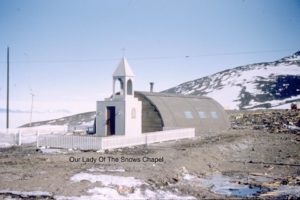 a bell from one of them somehow made its way up the hill to its place in the belfry. On May 6,1956, the Chapel was consecrated to Our Lady of the Snows and the bell consecrated to Saint Dismas, the good thief.”
a bell from one of them somehow made its way up the hill to its place in the belfry. On May 6,1956, the Chapel was consecrated to Our Lady of the Snows and the bell consecrated to Saint Dismas, the good thief.” rctica; while the first
rctica; while the first ay be the oldest Antarctic relic on the continent.
ay be the oldest Antarctic relic on the continent. Daniele Karlicek (pic aside), of the Department of Mathematics and Geosciences at the University of Trieste (Italy), did winter over a couple of times at the Italian-French Base “Concordia-Dome C” (WAP MNB-Ø3) in Antarctica, involved in a paleoclimatic research campaign as part of the research activities carried out at the Isotopic Geochemistry Laboratory of the University of Trieste.
Daniele Karlicek (pic aside), of the Department of Mathematics and Geosciences at the University of Trieste (Italy), did winter over a couple of times at the Italian-French Base “Concordia-Dome C” (WAP MNB-Ø3) in Antarctica, involved in a paleoclimatic research campaign as part of the research activities carried out at the Isotopic Geochemistry Laboratory of the University of Trieste. Now Daniele has informed WAP that, time ago, an Australian Organization which has probably seen the “ice Church” published somewhere, did ask him to set a video on this matter.
Now Daniele has informed WAP that, time ago, an Australian Organization which has probably seen the “ice Church” published somewhere, did ask him to set a video on this matter.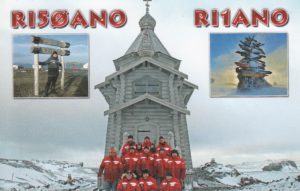 Bellingshausen Station (WAP RUS-Ø1) is a Russian (formerly Soviet) Antarctic Station at Collins Harbour, on King George Island of the South Shetland Islands.
Bellingshausen Station (WAP RUS-Ø1) is a Russian (formerly Soviet) Antarctic Station at Collins Harbour, on King George Island of the South Shetland Islands. In the Argentinean Base Belgrano II (WAP ARG-Ø6), in the Land of Coats, there is a cave carved in the ice. It is the most southern place of religious worship on the planet, only 800 miles from the South Pole. The Catholic Chapel of “Our Lady of the Snows” serves the base throughout the year. Unlike the other temples that appear in this entrance, the Chapel of Our Lady of the Snows is dug in the ice instead of being a building to use.
In the Argentinean Base Belgrano II (WAP ARG-Ø6), in the Land of Coats, there is a cave carved in the ice. It is the most southern place of religious worship on the planet, only 800 miles from the South Pole. The Catholic Chapel of “Our Lady of the Snows” serves the base throughout the year. Unlike the other temples that appear in this entrance, the Chapel of Our Lady of the Snows is dug in the ice instead of being a building to use.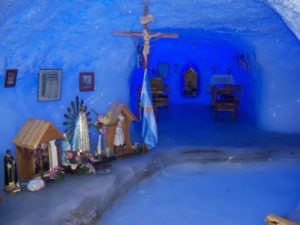
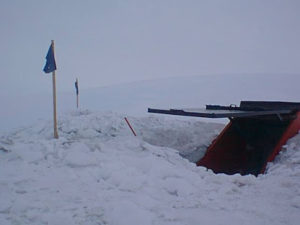
 On one of the thirteen Argentine Research Stations in Antarctica, Esperanza Base (WAP ARG-Ø4), we find the Chapel of San Francisco de Asís. The Esperanza base is inhabited all year round by civilians and is considered by the Argentines, as the southernmost city of the country, although it is only a small village. Besides the church, the base also has a school, a museum, a bar, a casino and a hospital with permanent maternity service and where enough Argentines have come to the world.
On one of the thirteen Argentine Research Stations in Antarctica, Esperanza Base (WAP ARG-Ø4), we find the Chapel of San Francisco de Asís. The Esperanza base is inhabited all year round by civilians and is considered by the Argentines, as the southernmost city of the country, although it is only a small village. Besides the church, the base also has a school, a museum, a bar, a casino and a hospital with permanent maternity service and where enough Argentines have come to the world.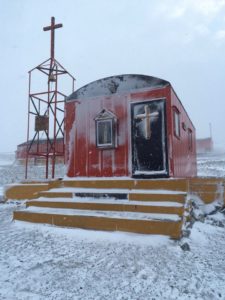 Christianity was first established in Antarctica by Captain Aeneas Mackintosh who erected a cross on Wind Vane Hill in 1916. The first religious service was conducted in Antarctica in 1947 by William Menster with about 2,000 people from different Christian denominations in attendance. Research and whaling stations were erected in the large area of Antarctica in the early 1900s. Since then, several scientists are attending the area especially during summer while a few people stay over during winter. The extended stay in the region can be stressful and challenging for researchers. The Jesuit geophysicists have contributed to the growth of religion in the continent through Antarctica mission work. The religion in Antarctica dates back to the discovery of the continent in 18th century. However, Christianity was the first religious practice in the continent.
Christianity was first established in Antarctica by Captain Aeneas Mackintosh who erected a cross on Wind Vane Hill in 1916. The first religious service was conducted in Antarctica in 1947 by William Menster with about 2,000 people from different Christian denominations in attendance. Research and whaling stations were erected in the large area of Antarctica in the early 1900s. Since then, several scientists are attending the area especially during summer while a few people stay over during winter. The extended stay in the region can be stressful and challenging for researchers. The Jesuit geophysicists have contributed to the growth of religion in the continent through Antarctica mission work. The religion in Antarctica dates back to the discovery of the continent in 18th century. However, Christianity was the first religious practice in the continent. For those who did not know, in 1975 the first Italian adventure in Antarctica did start by a private expedition carried out by a Milanese entrepreneur: Renato Cepparo.
For those who did not know, in 1975 the first Italian adventure in Antarctica did start by a private expedition carried out by a Milanese entrepreneur: Renato Cepparo.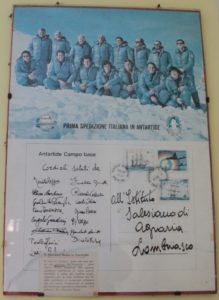 Now, going out the gymnasium of the Salesian Institute of Lombriasco (Turin, Italy) I did find, hanging on a wall, a postcard signed by the members of the Cepparo expedition, sent on December 25, 1975 from Antarctica to the Salesian Institute of Agriculture of Lombriasco; besides being a precious rarity, it’s a real scoop!
Now, going out the gymnasium of the Salesian Institute of Lombriasco (Turin, Italy) I did find, hanging on a wall, a postcard signed by the members of the Cepparo expedition, sent on December 25, 1975 from Antarctica to the Salesian Institute of Agriculture of Lombriasco; besides being a precious rarity, it’s a real scoop!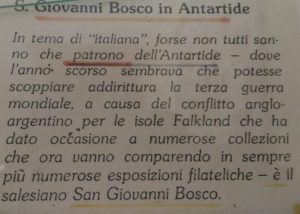
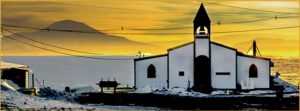 The Chapel of the Snows, a non-denominational place of worship at NSF’s McMurdo Station, Antarctica, overlooks McMurdo Sound and the Royal Society mountain range.
The Chapel of the Snows, a non-denominational place of worship at NSF’s McMurdo Station, Antarctica, overlooks McMurdo Sound and the Royal Society mountain range.
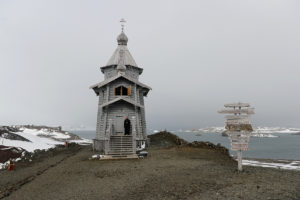 Members of the Antarctic Uruguayan ARTIGAS Base (WAP URY-Ø1), journalists and other guests visited the Trinity Church in Russia’s Bellinsghausen Polar Station (WAP RUS-Ø1) on King George Island, Antarctica, during the first week of December 2015. The priest explained to guest how the church was built as well as delivered a speech about the Orthodox and Christian churches in the twenty-first century. (see a video by cicking the gif aside)
Members of the Antarctic Uruguayan ARTIGAS Base (WAP URY-Ø1), journalists and other guests visited the Trinity Church in Russia’s Bellinsghausen Polar Station (WAP RUS-Ø1) on King George Island, Antarctica, during the first week of December 2015. The priest explained to guest how the church was built as well as delivered a speech about the Orthodox and Christian churches in the twenty-first century. (see a video by cicking the gif aside) 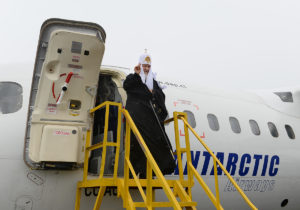
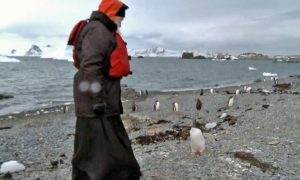
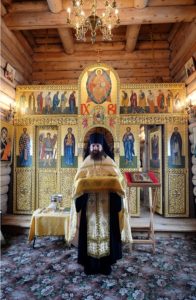

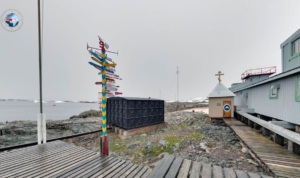 “When we send polar explorers to the South Pole we don’t ask about their confession, but every person can have a wish to be alone, to pray. Why don’t we build a church?” said Director of the National Ukrainian Antarctic Scientific Center, Valery Litvinov .
“When we send polar explorers to the South Pole we don’t ask about their confession, but every person can have a wish to be alone, to pray. Why don’t we build a church?” said Director of the National Ukrainian Antarctic Scientific Center, Valery Litvinov .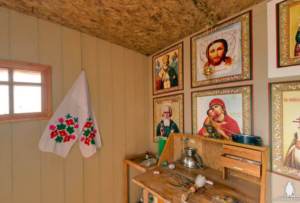
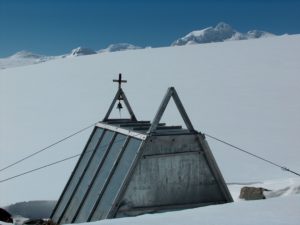 The Orthodox presence in Antarctica arises as parts of various expeditions from major Orthodox Christian Nations to the continent as there is not permanent population in Antarctica.
The Orthodox presence in Antarctica arises as parts of various expeditions from major Orthodox Christian Nations to the continent as there is not permanent population in Antarctica.
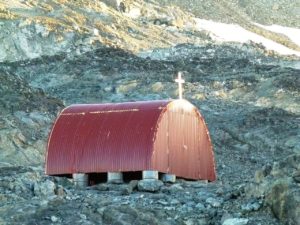 people, geologists, biologists, doctors, meteorologists, botanists and others .
people, geologists, biologists, doctors, meteorologists, botanists and others .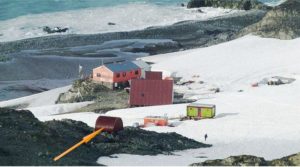
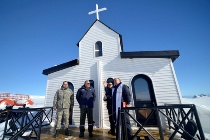 On Thursday 25 September 2014, the Commander in Chief of the IV Air Brigade, General Aviation Brigade Manuel Sainz Salas, did visit the Antarctic Air Base President Eduardo Frei Montalva and attended, with the Commander of the Air Base Group Commander (DA) Gonzalo Opazo, t
On Thursday 25 September 2014, the Commander in Chief of the IV Air Brigade, General Aviation Brigade Manuel Sainz Salas, did visit the Antarctic Air Base President Eduardo Frei Montalva and attended, with the Commander of the Air Base Group Commander (DA) Gonzalo Opazo, t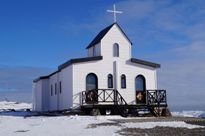 o the reopening ceremony of the Chapel of Santa Maria Reina de la Paz located at Villa Las Estrellas, the largest Chilean town in Antarctica. The Chaplain of the Unity Group Commander (SR) Juan Fuentes, blessed the new premises.
o the reopening ceremony of the Chapel of Santa Maria Reina de la Paz located at Villa Las Estrellas, the largest Chilean town in Antarctica. The Chaplain of the Unity Group Commander (SR) Juan Fuentes, blessed the new premises.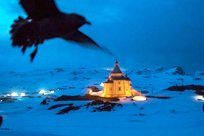 Interesting article pubblished on the New York Times by Ernesto Molina, a Chilean scientist, walking above the Russian Orthodox Church of the Holy Trinity, overlooking the Russian Antarctic base.
Interesting article pubblished on the New York Times by Ernesto Molina, a Chilean scientist, walking above the Russian Orthodox Church of the Holy Trinity, overlooking the Russian Antarctic base.